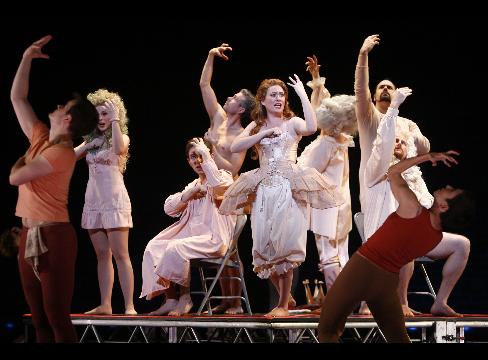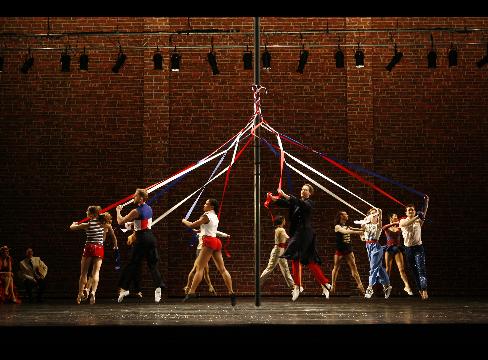This article originally appeared in the Culture section of Bloomberg News on March 7, 2008.
March 7 (Bloomberg) — “King Arthur,” John Dryden’s 1691 play in rhymed couplets, isn’t worth keeping, according to Mark Morris, but the songs Henry Purcell provided for it, with lyrics by the playwright, are beguiling.
So, for his production at the New York City Opera, the choreographer junked the spoken text (and therefore the plot, not to mention the king, who is represented only by a gimcrack crown).
Morris’s “vaudeville,” as he calls it, is a maverick ode to joy. The principal vocalists and the Mark Morris dancers frolic onstage while a chorus of singers shares the pit with the instrumentalists, vibrantly conducted by the early-music specialist Jane Glover.

The cast of New York City Opera’s “King Arthur” performs onstage with the Mark Morris Dance Group in New York on March 2, 2008. The show, which is a co-production of the English National Opera, the Mark Morris Dance Group, the New York City Opera, and Cal Performances, runs in repertory through March 15 at the New York State Theater at Lincoln Center in New York. Photographer: Carol Rosegg/New York City Opera via Bloomberg News
The piece has the deliberate feel of putting on a show from nothing but a few stray scraps, fleshed out with rampant imagination. Morris has two long-time allies to help him.
Isaac Mizrahi has provided extravagantly imaginative costumes from a wild medley of eras and occasions, some designed, others scavenged from opera storage rooms. Adrianne Lobel weighed in with a bare-bones stage and the skeletal props of a production in rehearsal.
The Morris/Purcell “King Arthur” dwells on the theme of love — of country, of nature and of unfettered erotic pleasure, shifting from one to the other in the blink of an eye.
Shivering Dancers
In the most elaborately zany and charming scene, a stiff old man representing Winter emerges from a Frigidaire as a miniature snow curtain scatters snowflakes and the shivering dancers wrap themselves in blankets. The crystalline soprano Mhairi Lawson plays Cupid, defrosting the place so that love can reign as it should.
The funny mock-military maneuvers that open the show — referring to the legendary Arthur’s Britons defeating the evil Saxons — are peacefully echoed toward the end in the patriotic devotion of the irresistible “Fairest Isle,” a song so tender and guileless, it shrugs off any accusation of chauvinism.
In between there are lewd shenanigans, a skewed fairy scene, an inexplicable but somehow endearing parade of random animals, paeans to British industry and a classical ballerina dressed to rehearse a Romantic ballet with her obligatory, if disoriented, cavalier. Purcell’s music remains equal to these latter-day translations, without losing its celestial beauties.

Members of the Mark Morris Dance Group dance around a maypole in New York City Opera’s “King Arthur” in New York on March 2, 2008. The show runs in repertory through March 15 at the New York State Theater at Lincoln Center in New York. Photographer: Carol Rosegg/New York City Opera via Bloomberg News
Acknowledging Purcell and Dryden’s era, Morris draws upon pre-classical dancing, including folk forms such as the deft braiding of maypole streamers. As usual, he includes visualizations of the songs’ lyrics, suavely incorporating the mimed words into the flow of dancing.
With all this oddly assorted stuff going on, it’s no wonder that “King Arthur” lacks the emotional and moral punch of Morris’s most memorable works. Still, it’s marvelous entertainment.
“King Arthur,” a co-production of the English National Opera, the Mark Morris Dance Group, the New York City Opera and Cal Performances, runs in repertory through March 15 at the New York State Theater, Lincoln Center, Broadway at 65th Street. Information: +1-212-721-6500; http://www.nycopera.com.
© 2008 Bloomberg L.P. All rights reserved. Reprinted with permission.



